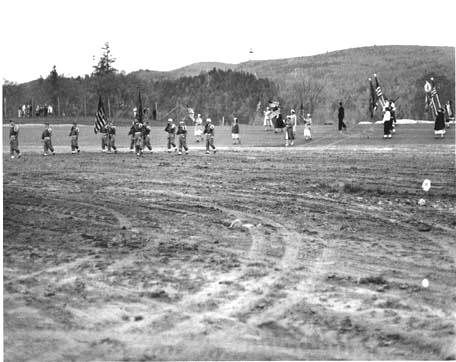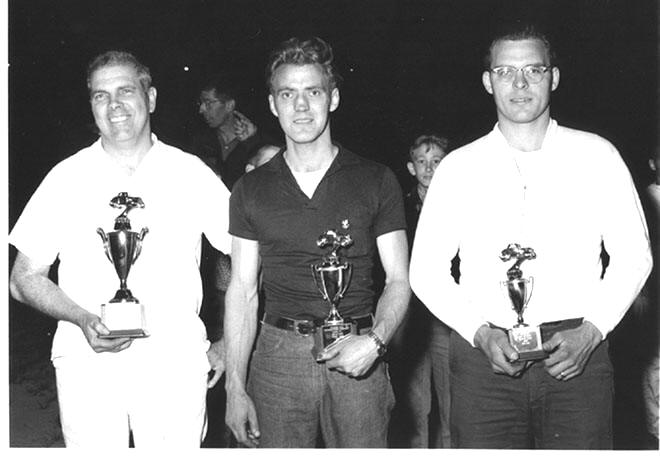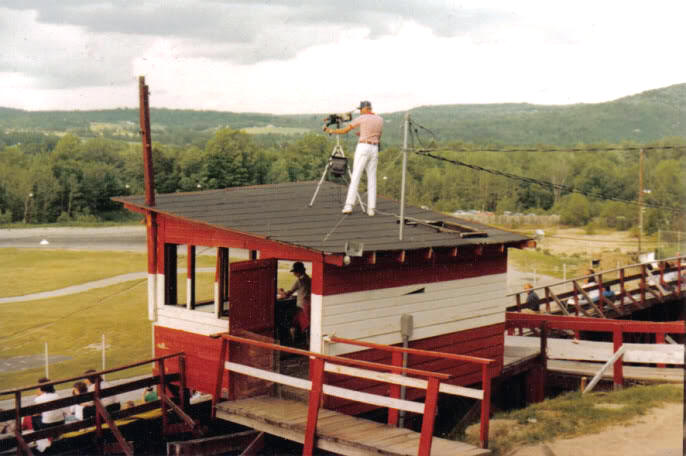Things were happening pretty fast around the turn of the decade, from the prosperity – bloated fifties to the controversy – plagued sixties. The stock car racing world in the North Country was no exception. Several prominent, and supposedly – stable race venues were disappearing from the scene: Mike Akhoury’s Stateline Speedway, near North Bennington, Vermont; Walter Barcomb’s Colchester – Bayview Speedway, in Colchester; Rhythm Inn Speedway, in Millers Falls, MA; Safford Park, at the county fairgrounds near Keene, NH; and several more tracks died out between 1958 and 1961.
At the same time, a seemingly invincible track operation opened in the northeastern corner of Vermont around 1959. The United Racing Club, a group made up mostly of men who worked at St. Johnsbury’s Ralston – Purina plant, carefully organized into a number of committees and designed a program to run a fifth – mile track in Lower Waterford, VT – near St. Johnsbury, which would be called Northeastern Speedway. The track offered many safeguards and plans, the lack of which had undone dozens of predecessor tracks nearby.

Courtesy of Cho Lee
Northeastern Speedway
launches its inaugural program with the
help of a local marching band in 1959. By 1964 it was gone.
A young traveling announcer named Ken Squier was very impressed with how the track was run and the success it was having. A man with some means, he planned, along with the Cooley brothers of Barre, VT, to design and build a paved quarter – mile track in the town of Barre. As things would turn out, after the two tracks shared an excellent roster of top notch flathead Ford racing teams in 1960 and 1961, the flashier Thunder Road International Speedbowl, located in a more populous area than Northeastern Speedway, began to erode the driver and fan support of Northeastern. By 1964, beset by both T Road and the newly – built Riverside Speedway in nearby Groveton, NH, Northeastern Speedway simply died.
Before, during, and after the struggles at Northeastern, Thunder Road was drawing tremendous crowds, which were treated to shows with large fields of primarily flathead Ford stock cars. Although a B class division did offer some late model hobby racing, the coupes were what put T Road on the map. A year ago, a notebook was made available to me. Apparently, an unnamed woman went to the races in 1960 at Barre and kept a rather complete and faithful account of the drivers and cars that appeared before her that year.
Courtesy of Cho Lee
Thunder Road’s high –
banked, paved quarter mile provided non – stop action from the very start.
Here, a
Marty Harty sedan [28 9/10] with Roger Lancey aboard avoids a pile up
involving the ? of Tubby Hatch. The R1 is
Dewayne Remick and the 71 is either Keith Ballard or Ernie Barcomb.
It is apparent that the amazing field of cars at Thunder Road arose largely from three sources: the local central Vermont area, western New Hampshire, and [to a lesser extent] from the then - mostly – dead Chittenden County stock car scene that had defined stock racing in the state in the 1950’s. The brief, but very impactful life span of Northeastern Speedway consolidated a core of high – performing drivers – many of which were from New Hampshires, which went over to T Road and dominated. In 1960, the top winner, by far, was the hulking Ronnie Marvin, of Bethlehem, NH, who won five features. The original “Intimidator”, Marvin, who almost completely filled the interior of his white 1932 Ford coupe, won three more than anyone else that year.
Another former Northeastern driver, Mutt Dexter of Lisbon, NH, won two features. The other driver to win two races was Rex Shattuck, decidedly different than the other two drivers. Shattuck, one of the earliest race drivers in northern Vermont, was from the Greater Burlington, Vermont area, which once boasted six tracks running almost simultaneously. While driving less and less as the ‘60’s went on, Shattuck continued to exercise a strong influence on T Road from the sidelines, fielding cars for prominent driver Black Jack DuBrul, Mickey Cross, and others.
Norman McIver Portrait Courtesy of Cho Lee
By Thunder Road’s
opening in 1960, Rex Shattuck had already
been racing around ten years.
For the Barre area drivers, none won more than one race in1960, and only two won at all – Mike Osborne, Norm Chaloux, and Larry Granger. Glenn Andrews, who would come all the way from Oxford, Maine to run, and Tony Colicchio, a transplanted Walpole, MA driver, were among the single feature winners.
The following year, Bradford, VT car owner George Barber brought in Keene, NH star Roy “Pappy” Forsyth, who won an unbelievable ten features, while Chaloux and Colicchio also managed multiple wins. Throughout the first half of the sixties, until the overhead V-8 sportsman took over, Thunder Road feature winners were overwhelmingly from New Hampshire. But, the fields during that time were an intriguing mix of almost – professional teams and very, very low budget groups.

Courtesy of Cho Lee
Keene, NH’s Pappy Forsyth [left], with one of his ten feature
trophies from the 1962 season. Larry Granger [center] and Bruce Pierson were
local drivers. Granger won several features at the track in the sixties,
himself. Ironically, Granger would
replace the retiring Forsyth in the Barber #46 car.
The Thunder Road winner lists in that period are all about Ronnie Marvin, Harold Hanaford, and the Ingerson brothers; but, there were also Vermonters Johnny Gammell, Mike Osborne, Larry Granger, Norm Chaloux, and many more. The former Chittenden County brigade faded out of the picture soon, with some going off to the newly – built Otter Creek Speedway, near Vergennes, VT. Shattuck, who won at least five T Road features, was – by far – the standard bearer and little – known Dick Hawkins, of Ferrisburg, managed one victory in a blue Hudson numbered “2 + 1”.
The Thunder Road International Speedbowl always had its share of little – knowns and never – made – its filling out the rosters. Guys like Teddy Kendall, with his K22; Perley Densmore, whose wife flattened his car in a powder puff race; Pete Pierson, from tiny East Corinth, VT; Al Whitcomb, whose car number came from a Caterpillar bulldozer model; and Floyd Densmore were among the dozens of competitors whose name did not make much of a splash in that highly – competitive atmosphere.
Courtesy of Cho Lee
Perley Densmore managed
this damage without any help from Mabel. Below - Mabel's
handiwork, at Northeastern.
Courtesy of
Paul Bellefeuille
The track attracted some noteworthy visiting stars. NASCAR National Sportsman champion, Rene Charland, ran much of the 1965 season with the potent George Hay #68 out of Hardwick, VT to gain as many national points as he could. The Hay team car was in a period of flux after regular driver, Ray Stygles, had nearly been killed when he went off turn four and hit a tree. Midget star King Carpenter and NASCAR National Modified Champion Ernie Gahan would take turns in the Bud Messier 50 coupe. Messier’s car, which seemed to attract mostly guest stars, was also run successfully by Claremont Speedway standout Mike Cody.
High – powered teams like Andy Cote’s three car program ran, head – to – head with low buck outfits like Chester T. Wood, from Orange, VT, who sat on a tractor seat in a coupe held together with baling wire. The nicknames were many and varied. Clarence “Cornfield” Rock, who occasionally ran Jim Hampton’s 2 + 1, got his name from his propensity to fly off tracks. Henry “The Frozen Logger” Montandon, a popular little man from tinyWaits River, VT went to his grave insisting he had no idea why Ken Squier dubbed him that. So, too, does Harold “Hardluck” Hanaford, one of the track’s most successful drivers, say he is not sure about his nickname. These can be added to Black Jack, Cuffy, and Pappy.
Courtesy of Cho Lee
Legendary Canadian
driver Jean – Paul Cabana, one of the famous drivers to try out the Bud
Messier #50
coupe at Thunder Road. Messier had several big name drivers in that car.
Thunder Road spent the remainder of the
1960’s operating in the shadow of the newly – built Catamount Stadium, which
Squier, the Cooleys, DuBrul, and others set up outside of Burlington, Vermont.
NASCAR came in with Catamount and – by 1966 – Thunder Road’s beloved flathead
coupes had been regulated out of the picture. Barre fans would have to watch
fields of overhead V-8’s, largely from out of state. Back in 1967, it would
have raised a few eyebrows if someone was to say that Thunder Road would
outlive Catamount Stadium by a number of decades.
For
many Thunder Road enthusiasts, including my late friend Cho Lee, those first
years [1960 - 1964] were the best that were ever held at the Nation’s Site of
Excitement. They certainly involved some of the most interesting fields of
cars and personalities.

Courtesy of Andy Boright
A preparing
photographer enjoys the amazing view the crowd gets at Thunder Road
International Speedbowl. This is in the 1960’s, and – in many ways – the track
remains the same today.
Please email me if you have any photos to lend me or information and corrections I could benefit from. Please do not submit anything you are not willing to allow me to use on my website - and thanks. Email is: wladabou@comcast.net . For those who still don’t like computers - my regular address is: Bill Ladabouche, 23 York Street, Swanton, Vermont 05488.